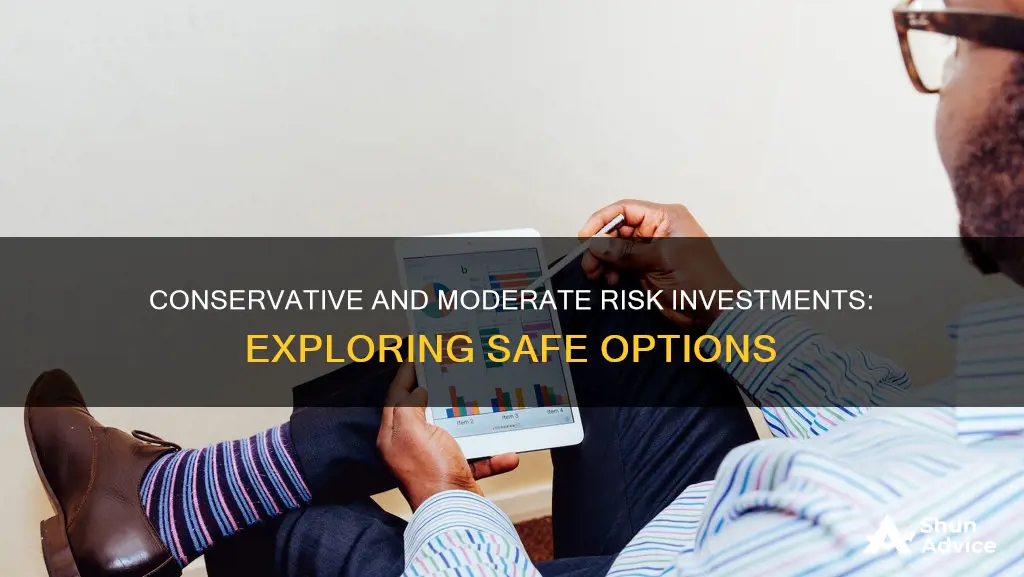
When it comes to investing, it's important to understand your risk tolerance, which is the degree to which you are comfortable with your money fluctuating with market changes. This will guide your approach to investing and help you decide between conservative, moderate, and aggressive investment options. Conservative investing prioritises the preservation of capital and current income over growth, focusing on lower-risk securities such as bonds, cash, and cash equivalents. Moderate-risk portfolios allow investors to experiment with different types of investments while also allocating a portion of their funds to safer options. This typically involves a balanced mix of stocks and bonds. Understanding your investment goals, time horizon, and risk tolerance will help you determine whether conservative or moderate-risk investments are the right choice for you.
| Characteristics | Values |
|---|---|
| Risk tolerance | Low to moderate |
| Investment goal | Short-term |
| Investment type | Low-risk investments like CDs and Treasurys |
| Investment portfolio | Combination of 20-40% risky investments (like stocks) and 60-80% of safer investments (like bonds) |
| Investment strategy | Preservation of capital and current income |
| Investment instruments | Debt securities, cash equivalents, Treasuries, high-quality bonds, money markets, cash, Treasury bills, certificates of deposit |
What You'll Learn
- Conservative investing: Prioritise capital preservation and income over growth
- Moderate investing: Experiment with different investments while keeping some money in safer funds
- Risk tolerance: Understand your comfort with market fluctuations to guide your approach
- Low-risk investments: Safe assets with a minimal risk of loss, like Treasurys and CDs
- Diversification: Mix low-, moderate- and high-risk investments to balance safety and growth

Conservative investing: Prioritise capital preservation and income over growth
Conservative investing is a strategy that prioritises capital preservation and income over growth. It seeks to protect an investment portfolio's value by investing in lower-risk securities. A conservative investment portfolio will generally hold more than half of its assets in debt securities and cash equivalents, such as bonds, and cash or cash equivalents, rather than equities or other risky assets.
Conservative investors have risk tolerances ranging from low to moderate. Their portfolios will include a relatively high weighting of low-risk securities, such as high-quality bonds, money markets, and cash equivalents. These investors are comfortable with lower returns in exchange for safety.
A conservative investment strategy is often adopted by older individuals who are nearing retirement age and require a steady income without the risk of losing their capital. It is also a strategy used by those who believe that asset prices will decline.
Some examples of conservative investments include:
- Treasury securities: T-bills, T-notes, and Treasury Inflation-Protected Securities (TIPS) are considered very low-risk as they are backed by the US government. They offer a safe way to earn a return, although generally lower than aggressive investment strategies.
- Money market funds: These invest in stable, short-term debt instruments and certificates of deposit. They offer higher yields than savings accounts and are suitable for those seeking yield and safety.
- Certificates of Deposit (CDs): CDs are low-risk, FDIC-insured investments offering fixed interest rates over a set period. They are well-suited for investors who don't need immediate access to their funds and are ideal for those seeking higher, guaranteed returns.
- High-yield savings accounts: These accounts offer a low-risk option with higher interest rates than regular savings accounts. They are ideal for short-term savings goals, providing both security and liquidity.
- Investment-grade corporate bonds: These are considered low to moderate risk, offering moderate returns with a lower default risk.
Conservative investing is a cautious approach to investing, focusing on capital preservation and stable income. While it may not offer high returns, it provides safety and peace of mind for investors with a low to moderate risk tolerance.
Invest Wisely: Educba on Why It Matters
You may want to see also

Moderate investing: Experiment with different investments while keeping some money in safer funds
Moderate investing is a medium-risk strategy that allows you to experiment with different types of investments while also putting some of your money in safer funds. It's a balanced approach that offers the opportunity to explore diverse investment options without taking on excessive risk. Here are some key considerations for moderate investing:
Asset Allocation
Moderate investors typically allocate their portfolio with a combination of stocks and bonds. A moderate-risk portfolio usually comprises 40% to 60% stocks (riskier investments) and 40% to 60% bonds (safer investments). This allocation provides a balance between potential growth and stability. Stocks offer the potential for higher returns but come with greater risk, while bonds provide more stability and regular income.
Investment Options
When it comes to moderate investing, you can explore a range of investment options. Here are some examples:
- Stocks: Moderate investors can allocate a significant portion of their portfolio to stocks, focusing on a mix of large-cap, established companies, and potentially some riskier options like small-cap or growth stocks. Diversification across sectors and industries is essential to manage risk.
- Bonds: Investment-grade corporate bonds, government bonds, and municipal bonds are suitable options for moderate investors. These bonds offer a steady income stream and relatively lower risk compared to stocks. Diversifying your bond holdings can further reduce risk.
- Mutual Funds and ETFs: Mutual funds and exchange-traded funds (ETFs) offer moderate investors a diversified approach to investing. These funds hold a mix of stocks and bonds, providing exposure to different markets and industries. Mutual funds and ETFs are professionally managed, making them a convenient option for moderate investors.
- Money Market Funds: Money market funds invest in stable, short-term debt instruments and certificates of deposit (CDs). They offer moderate returns and are considered low-risk investments. While they are not FDIC-insured, they aim to maintain a stable $1 per share value.
- High-Yield Savings Accounts: High-yield savings accounts offer a low-risk option with higher interest rates than regular savings accounts. They are FDIC-insured, providing security and easy accessibility to your funds.
Risk Management
Moderate investing acknowledges that some level of risk is acceptable. However, it's important to manage this risk effectively. Diversification is a key risk management strategy, ensuring that your portfolio is not overly exposed to any single investment or market. Regular portfolio rebalancing is also important to maintain your desired asset allocation as the value of your investments fluctuate over time.
Additionally, it's crucial to understand your risk tolerance and adjust your strategy accordingly. Moderate investors can generally tolerate small market fluctuations but should be cautious about taking on too much risk. If your risk tolerance changes over time, you may need to adjust your investment strategy to match your new comfort level.
Investment Horizon
Moderate investing is often associated with a longer investment horizon. Historically, moderate and aggressive investment strategies have experienced higher returns over more extended periods. If you're investing for the long term, you can ride out short-term market fluctuations and focus on potential long-term gains. However, it's important to note that past performance does not guarantee future results.
Understanding Managed Investments: What Are Listed Managed Investments?
You may want to see also

Risk tolerance: Understand your comfort with market fluctuations to guide your approach
Risk tolerance is a crucial aspect of investing, and understanding your comfort level with market fluctuations is essential to guide your investment approach. Everyone has a different risk tolerance, and it's important to be honest with yourself about how much risk you're willing to take. Here are some factors to consider when assessing your risk tolerance:
Time Horizon
How soon you need to access your funds is an important consideration. If you're investing for the short term, you may want to take on less risk to ensure your money is there when you need it. Conversely, if you have a longer time horizon, you may be more comfortable with market fluctuations and opt for moderate- to higher-risk investments, which have historically yielded higher returns over time.
Investment Goals
Understanding your investment goals is crucial in determining your risk tolerance. Are you investing for retirement, saving for a specific purchase, or looking to generate additional income? If you're investing for retirement, your risk tolerance may be different from someone saving for a down payment on a house.
Comfort with Volatility
How comfortable are you with the idea of your investments fluctuating in value? If the idea of market ups and downs keeps you up at night, your risk tolerance is likely on the conservative side. On the other hand, if you're comfortable with volatility and market fluctuations, you may have a higher risk tolerance.
Financial Situation
Your financial situation plays a significant role in determining your risk tolerance. If you're investing with disposable income and can afford to take on more risk, your approach may be different from someone investing their entire life savings. It's important to assess your financial circumstances and how much risk you can comfortably take.
Stress and Emotional Factors
Investing should not cause you undue stress or anxiety. If you find yourself constantly worried about market movements, it may be a sign that your risk tolerance is lower than you initially thought. It's important to strike a balance between your financial goals and your emotional comfort.
Once you've assessed your risk tolerance, you can start exploring investment options that align with your comfort level. Here are some options for conservative and moderate-risk investments:
Conservative Investments
Conservative investing prioritises capital preservation over aggressive growth. These investments typically have a larger proportion of low-risk securities such as bonds, cash, and cash equivalents. Examples include:
- US Treasury securities (T-bills, CDs, TIPS)
- Money market funds
- Investment-grade corporate bonds
- High-yield savings accounts
- Preferred stocks
- Fixed-income securities
Moderate-Risk Investments
Moderate-risk portfolios strike a balance between conservative and aggressive strategies. They typically involve a mix of stocks and safer investments, such as:
- A combination of stocks and bonds
- Mutual funds or ETFs
- Municipal bonds
- Investment-grade corporate bonds
- High-yield savings accounts
- Money market funds
Remember, investing always carries some level of risk, and it's important to do your own research and consult with a financial professional before making any investment decisions.
Reviewing Your Investment Portfolio: A Comprehensive Guide
You may want to see also

Low-risk investments: Safe assets with a minimal risk of loss, like Treasurys and CDs
Low-risk investments are those that have a minimal risk of loss and are perfect for older investors nearing retirement or anyone who wants to prioritise capital preservation and stable, modest returns. They are also a good option for those who are new to investing and want to learn more without taking huge risks. Treasurys and CDs are two examples of low-risk investments.
Treasurys
Treasury securities like T-bills and T-notes are very low-risk as they are issued and backed by the US government. They are considered "risk-free" since the federal government guarantees them and have a very low default risk. Treasurys are also highly liquid due to an active secondary market.
CDs
Certificates of deposit (CDs) are available from banks or credit unions and work like savings accounts but offer a slightly higher interest rate. They are insured by the Federal Deposit Insurance Corporation (FDIC) and guaranteed up to $250,000. CDs are also very safe, but one risk is inflation, which may cause the money to lose its buying power over time.
Other Low-Risk Investments
Other low-risk investments include money market funds, annuities, investment-grade corporate bonds, and cash-value life insurance.
Conservative and Moderate Risk Investments
Conservative portfolios are for those with a low-risk tolerance and typically include a combination of 20-40% risky investments (like stocks) and 60-80% safer investments (like bonds). Moderate portfolios allow investors to experiment with different types of investments and usually include a combination of 40-60% stocks and 40-60% bonds.
Private Investment in India: What's the Deal?
You may want to see also

Diversification: Mix low-, moderate- and high-risk investments to balance safety and growth
Diversification is a key strategy for investors looking to balance safety and growth. By mixing low, moderate, and high-risk investments, you can tailor your portfolio to your risk tolerance and financial goals while maintaining a safety net. Here are some things to consider when diversifying your portfolio:
Understanding Risk Tolerance
Firstly, it's important to assess your risk tolerance. This will guide your approach to investing. Ask yourself how comfortable you are with the ups and downs of the financial markets. If you're investing for the long term, you may be more open to taking on risk, knowing that you have time to recover from downturns. On the other hand, if you're nearing retirement, you may want to shift towards more conservative investments to preserve your capital.
Conservative Investments
Conservative or low-risk investments aim to preserve capital and provide stable, modest returns. Examples include:
- Treasury securities: These are considered "risk-free" as they are backed by the federal government. They offer a safe haven during volatile markets and provide high liquidity.
- Certificates of Deposit (CDs): CDs are low-risk, FDIC-insured investments offering fixed interest rates over a set period. They are suitable for those seeking higher returns than savings accounts without immediate access to funds.
- Money market funds: These funds invest in stable, short-term debt instruments and CDs, offering higher yields than savings accounts with liquidity and safety.
- Investment-grade bonds: Short-duration, high-quality bonds with a lower default risk offer moderate returns.
Moderate Investments
Moderate-risk investments allow you to experiment with different types of investments while maintaining a balanced approach. A typical moderate-risk portfolio comprises:
- 40-60% stocks: Stocks are considered riskier investments due to their volatility but offer the potential for higher returns.
- 40-60% bonds: Bonds are considered safer investments and provide stable, modest returns.
High-Risk Investments
High-risk investments focus on growth and maximizing returns. These investments are suitable for those with a high-risk tolerance:
- Aggressive portfolios: These portfolios consist of 80-100% stocks and 0-20% bonds. They are designed for those seeking the highest possible returns over the long term.
- Growth portfolios: These portfolios may include high-risk small-cap stocks, such as new technology companies, or international equities in emerging markets.
Benefits of Diversification
Diversification across asset classes helps to avoid overexposure to any one type of risk. A well-diversified portfolio can provide stability, predictable income, and protection against market volatility. It allows you to balance safety with growth opportunities, ensuring you don't put all your eggs in one basket.
Savings Surplus: Impact on Economy and Investment Opportunities
You may want to see also
Frequently asked questions
Conservative and moderate investors can choose from a variety of investment options, including:
Conservative investment strategies prioritise capital preservation over high returns and involve investing in lower-risk securities. A conservative portfolio typically includes:
- 20-40% stocks
- 60-80% bonds and other safer investments
Examples of conservative investments include:
- Blue-chip stocks
- Fixed-income securities
- Money market funds
- Cash or cash equivalents
- Treasury bills and certificates of deposit (CDs)
A moderate-risk investment strategy allows for a mix of investments, with a balanced approach to risk and returns. A moderate portfolio typically includes:
- 40-60% stocks
- 40-60% bonds and other safer investments
Examples of moderate-risk investments include:
- A mix of stocks and bonds
- Intermediate or Moderate investment options







